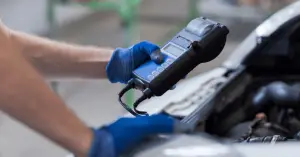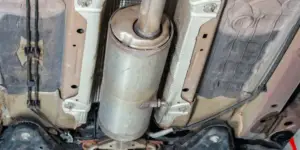
While it isn’t an especially common problem, there are a fair number of people who have dealt with the issue of their automatic transmission going into gear, but their vehicle not moving. It is a particularly annoying problem if you have somewhere you need to be. So, we figured that we would look at why this issue occurs and, hopefully, help you to fix it. With that said, what is the reason that your automatic transmission goes into gear but won’t move?
Chances are, the automatic transmission going into gear but the vehicle not moving is due to an issue with the transmission fluid. It could either be dirty or be running low. In rare cases, it may be due to a damaged automatic transmission, or issues with your vehicle’s onboard computer.
Let’s help you to diagnose the problem and, hopefully, get your vehicle up and running again!
How To Tell If the Automatic Transmission is The Problem
Truth be told, you can’t really tell that the automatic transmission is the problem with your vehicle. If the automatic transmission appears to be working and the vehicle isn’t moving forward, chances are that the problem is with the transmission, but it is far from guaranteed.
Over the next few sections, we will help you to identify the problem. We will also give you a few potential solutions to the problem. However, you should bear in mind that many transmission issues are not going to be easy to fix if you don’t have a clue how to work with vehicles. Most of the time, it is probably best to head to the garage and have the problem looked at.
Why Your Automatic Transmission Goes Into Gear But Won’t Move
Our goal here is to help you to identify the reasons behind your automatic transmission issues. Basically, this is a troubleshooting guide. We’ll go through the main causes of an automatic transmission problem and how you can identify them.
Do bear in mind that we cannot possibly cover everything here. Cars are very complicated machines, and there may be problems that are limited to your vehicle. As vehicles get ever more complicated, there may be new reasons why your automatic transmission may be engaging but your vehicle isn’t moving. We reckon that we have covered around 90% of the reasons here, though.
1. Dirty or Low Transmission Fluid

Manual vehicles need their transmission fluid changed frequently. Probably once every 1-2 years. Automatic vehicles don’t. In fact, you could probably go 3-4 years before you need to change your transmission fluid. As a result, a lot of automatic vehicle owners forget.
If you have an automatic vehicle and have not changed your transmission fluid over the last couple of years, then the chances are pretty high that this is the cause of your problems. Dirty transmission fluid can hinder the transmission. We suggest you look at the transmission fluid. If it is brown or a darker color, then replace it. It means it is old.
In some cases, your transmission fluid could be leaking. If you notice a pool of a red fluid under your vehicle (particularly in places where your vehicle is parked for a long time), then your transmission fluid is leaking.
If you have a leak, then refilling the transmission fluid won’t be enough. You have to deal with the source of the leak. Unfortunately, this is not something that you can fix yourself. You will need to head to a professional mechanic so they can diagnose and resolve the issue.
2. Your Vehicle Switched to Reduced Power Mode
In theory, this shouldn’t prevent your vehicle from moving. It happens, but it will mostly prevent your vehicle from changing gears i.e. you’ll always be stuck in 1st gear.
Most vehicles switch to Reduced Power Mode if there is a small issue causing low power in the engine e.g. poor airflow, fuel delivery, battery power, etc. So, if you notice that the ‘Check Engine’ light is on, then chances are that this may be the problem with your automatic transmission.
Your vehicle’s manual should contain a checklist of reasons why Reduced Power Mode may be happening. We suggest that you go through the checklist and work out the reasons. Most of the time, you need to do nothing more than charge your battery or clean some air filters.
In some cases, your vehicle may have a way to bypass Reduced Power Mode. Again, you’re going to need to read through your vehicle’s manual to determine how to do this. It will vary from vehicle to vehicle.
3. Broken Shift Cable
The shift cable plays a key role in your vehicle’s transmission. It is a link between the driver and the transmission box.
When the vehicle changes gear, the shift cable is activated. When the shift cable moves, the correct gear should be selected.
If the shift cable is damaged, it won’t work properly. The automatic transmission won’t be able to select the right gear in the transmission box, which would either prevent your vehicle change gears or, worse, your vehicle not moving at all.
Most of the time, it should be easy to tell if the shift cable is damaged. It is located on the underside of the vehicle, on the driver’s side. You’ll physically see the break. If you want to see where the shift cable is in your vehicle, we suggest that you read through your vehicle’s manual. It should tell you where every part is.
4. Transmission Range Sensor is Damaged
When your vehicle’s automatic transmission changes gears, it sends a signal to your vehicle’s central control computer (known as the PCM). This is all down to a sensor where the automatic transmission is. This is known as the transmission range sensor.
In rare cases, the transmission range sensor can be damaged. When it is damaged, it may tell your vehicle the wrong information. For example, it may tell your vehicle’s central computer that the vehicle is in Park when it should be in gear. If the vehicle thinks it is in park, then the vehicle won’t move.
Unfortunately, this isn’t an easy problem to identify since you can’t really see whether a transmission range sensor is working. About the only time you know that there is a problem is if warning lights start flicking up on your vehicle’s dashboard. Although, even that may not happen. It is really something that will need to be inspected by a professional.
5. Worn Clutch
As your vehicle gets older, the chances of your clutch wearing down increase. It is a gradual process. If you have noticed the following before your vehicle ultimately stopped moving, then the issue could be with the clutch:
- Gears slipping when you are driving
- Sudden increase or decrease in vehicle RPM
- A grinding noise when the gears change.
6. Damaged Torque Converter
A torque converter is a very, very important component in an automatic vehicle. It allows the vehicle’s engine to spin at a different speed from the transmission. As you can probably guess, the torque converter can fail.
You’ll know your torque converter may be the issue if you spotted these problems before the automatic transmission stopped working:
- Major transmission fluid leaks
- Regular overheating of the transmission
- A low rumbling sound, particularly when you slow down the vehicle.
- Loss of acceleration.
7. Issues with the Vehicle’s Computer (Error Codes)

An OBD-2 scanner is a small computer that you can plug into your vehicle’s computer.
When you are driving, your vehicle’s computer is looking out for any issues with the vehicle, whether it be big or small. The issues may not be apparent to you, but the vehicle’s computer logs everything.
If you have an issue with your vehicle’s automatic transmission, then chances are that your vehicle’s computer will be log it in the form of an error code. If you can plug an OBD-2 scanner into your vehicle (they’re not too expensive), you can read the error codes and find out the exact issue.
8. Damaged Automatic Transmission
Finally, your automatic transmission could just be broken. Remember, an automatic transmission is pretty complicated. It has all sorts of sensors, components, wires, and more. Basically, there is a lot that can go wrong with it.
This is another problem that is tough to diagnose, and it is more a process of elimination than anything else.
How To Fix Automatic Transmission Going Into Gear and Not Moving
Somewhat annoyingly, you cannot fix most of these issues at home. They require a decent amount of vehicle knowledge and access to specialist equipment. So, even if you have diagnosed the problem, we suggest that you head to a garage have a mechanic fix it for you. The only thing that you can do yourself is check your transmission fluid levels, which we will tell you how to do now.
How to Check Transmission Fluid Levels
The first thing that you need to do is start your vehicle to ensure that low transmission fluid levels are the reason for the problem. Leave it running for about 10-15 minutes.
Once the transmission fluid has heated up a bit, turn the vehicle off and locate the transmission fluid’s dipstick. Your vehicle’s manual will point out exactly where it is under the hood.
Look at the dipstick, and it should tell you whether your transmission fluid levels are running low. If they are, it is time to refill.
How To Refill Transmission Fluid
If your transmission fluid is filthy i.e. a dark red or brown color, then head to a garage. You may need to have the entire transmission system flushed. This is something that you can do yourself, but it is a long and cumbersome process. It is also incredibly messy. The only thing that you can really do at home is refill the transmission fluid which, thankfully, is rather easy:
Refilling Your Transmission Fluid
Make sure that you buy the right transmission fluid for your vehicle. Once you have it, do the following:
- Turn your vehicle on. Leave it in park with the handbrake applied.
- Place a funnel on the transmission fluid refill hole (where you got the dipstick from).
- Gently pour a small amount of transmission fluid in.
- Check the dipstick.
- Add a small amount more, and check again.
The key is to only put small amounts of transmission fluid in at a time. This will prevent you from overfilling the transmission fluid, which could cause all sorts of issues.
Final Thoughts
If your vehicle’s automatic transmission goes into gear but won’t move, it could indicate a serious problem. Sometimes, it could be something as simple as needing to refill the transmission fluid, or as complicated as replacing the entire automatic transmission system. Most of the time, the problem is very easy to diagnose. It is just hard to fix unless you have a lot of experience with vehicles.
Frequently Asked Questions
What Is a Sign of Low Transmission Fluid?
Either overheating or a burning smell will likely be the first sign of a low transmission fluid. If transmission fluid levels continue to plummet, your vehicle may not move at all.
How Much Does it Cost to Fix a Broken Automatic Transmission?
It depends on the problem. You can probably fix a simple issue $100+, but a complete automatic transmission replacement could easily cost thousands.
Why Is My Vehicle Not Moving Despite Being in Gear?
Chances are that there is an issue with your automatic transmission. It could be down to low fluid levels, or a much deeper problem.













